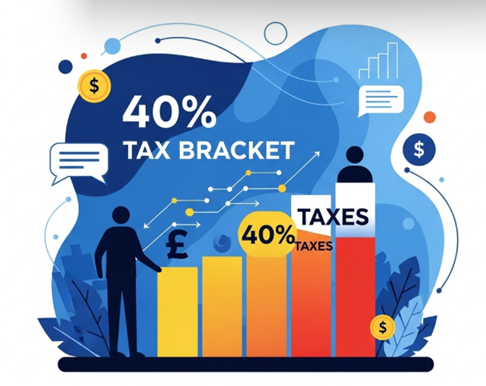-
News
-
Blog
-
Archive

Understanding the Higher Rate Tax
The UK's progressive tax system includes the 40% tax bracket, sometimes referred to as the Higher Rate. At the moment, it covers taxable income in England, Wales, and Northern Ireland that falls between £50,271 and £125,140 per tax year. Only the portion of your earnings that falls within this range is subject to 40% taxation.
How UK Income Is Taxed – 2025/26
Tax Band |
Taxable Income (£) |
Rate |
Personal Allowance |
0 – 12,570 |
0% |
Basic Rate |
12,571 – 50,270 |
20% |
Higher Rate |
50,271 – 125,140 |
40% |
Additional Rate |
Over 125,140 |
45% |
(Note: Personal allowance reduces for incomes over £100,000)
Example Scenario
Suppose you earn £60,000:
- First £12,570 = 0%
- Next £37,700 = 20% ? £7,540
- Remaining £9,730 = 40% ? £3,892
Total annual tax: £11,432 (before National Insurance).
Why Only Part of Your Income Is Taxed at 40%
Your lower earnings still benefit from the lower rates because the higher rate is marginal, meaning it only applies to earnings within its band. The tax burden is equitably distributed thanks to this design.
Broader Considerations
- Your personal allowance is gradually reduced if your income exceeds £100,000, which effectively raises your marginal rate to 60% on some incomes before stabilizing at 40%.
- By freezing thresholds until 2028, the UK government may be able to "fiscal drag" more people into the 40% bracket.
How an Accountant Can Help
Accountants in Bolton can:
- Plan income to manage or avoid crossing into the 40% band unexpectedly.
- Use pension contributions or charitable donations to reduce taxable income.
- Advise on broader tax-efficient strategies to protect take-home pay.
Final Takeaway
Only income between £50,271 and £125,140 is subject to the 40% tax bracket. Strategic tax planning, ideally with knowledgeable accountants in Bolton, can help you minimize your overall tax liability and increase your financial efficiency if you're getting close to the threshold.